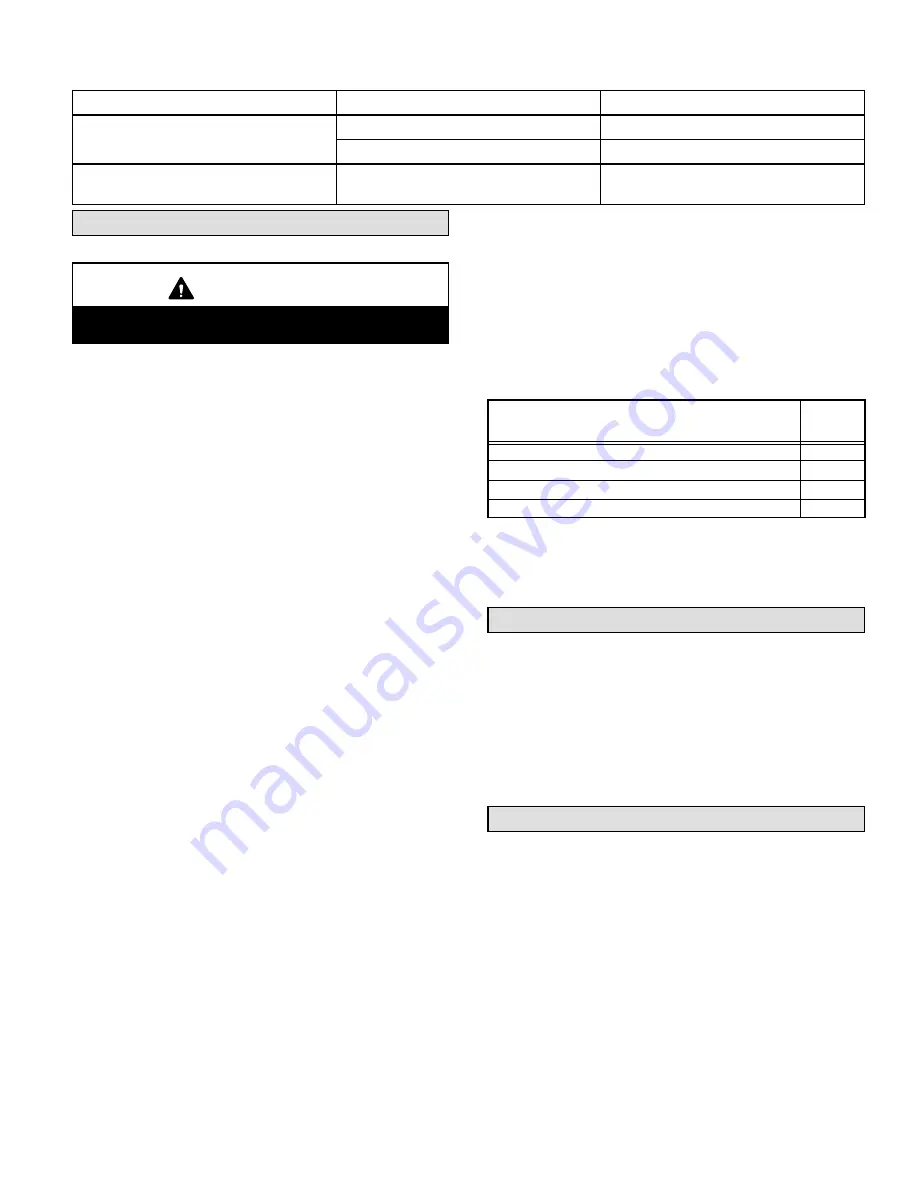
Page 13
Table 6
Fuel Pump Usage
Pump
Piping Application
Maximum Lift (vacuum)
Single-Stage Pump
One-Pipe System
8 ft. (6” Hg vacuum)
Two-Pipe System
10 ft. (12” Hg vacuum)
Two-Stage Pump
Two-Pipe System
10 ft. or greater
(12” to 17” Hg vacuum)
Oil Supply Line & Filter Connections
One-Pipe Systems
CAUTION
Do not install the bypass plug into the pump on one-
pipe systems.
The burner is shipped with fuel pump set for one-pipe op
eration. For one-pipe systems, the oil supply pipe is con
nected to the inlet tap on the pump. A one-pipe system
should only be used where there is gravity oil flow to the
pump and the pipe is not run at any point above the oil level
in the tank.
1 - Connect the inlet pipe to the pump inlet. Start the
burner.
2 - Set the primary burner control for continuous opera
tion during purging.
3 - Turn the bleed valve one turn counterclockwise to
open.
4 - Bleed the unit until all air bubbles disappear.
NOTE - Hurried bleeding will prevent the unit from op
erating properly.
5 - Tighten the bleed valve securely.
Two-Pipe Systems
If the installation requires a two-pipe operation, install the
bypass plug included in the bag which is attached to the
pump. To convert the pump, install the bypass plug ac
cording to the provided pump instructions. Notice in the
two‐pipe system the return pipe must terminate in the tank
3” (76 mm) to 4” (102 mm) above the supply inlet. Ensure
the return pipe terminates at the correct measurement or
air may escape into the system. This could result in loss of
prime.
NOTE- If using an outside tank in cold climates a number
one fuel or an oil treatment is strongly recommended.
1 - Remove 1/4” plug from return port.
2 - Insert bypass plug and tighten it. See figure 13.
3 - Attach the return and inlet pipes. Start the burner. Air
bleeding is automatic.
NOTE - If a faster bleed is necessary, open the bleed
valve.
4 - The return pipe must terminate 3” to 4” above the sup
ply pipe inlet. See figure 13.
NOTE - If the return pipe does not terminate where it
should, air may enter the system, and prime may be
lost.
An oil filter is required for all models.
Install a field sup
plied oil filter inside the building between the tank shut‐off
valve and the burner. Locate filter close to burner for easy
maintenance. Table 7 lists the filters for the ELO183DH
furnace.
Table 7
Oil Filters
Cat.
Number
10 micron filter (no mounting bracket)
81P89
10 micron filter (mounting bracket)
53P92
10 micron replacement cartridge for filter, 45 gph
53P93
Filter restriction indicator gauge
53P90
Consult burner manufacturer's instructions packaged with
unit for further details concerning oil supply pipe connec
tions.
Leak Check
After oil piping is completed, carefully check all piping con
nections (factory and field) for oil leaks.
Oil Line Heater (Optional)
A heater for the oil line is available for applications that are
located in cold climates. The heater warms the oil pipe to
assist the initial start-up. An oil line heater is available from
Beckett using part number 51621 (Beckett Start Helper).
Electrical Wiring
All wiring must conform to the National Electric Code
(NEC), or Canadian Electric Code (CEC) and any local
codes.
1 - Refer to the appliance rating plate for proper fuse size.
2 - Install the room thermostat and make wire connec
tions to the control. Avoid installing thermostat on an
outside wall or where it can be affected by radiant heat.
Set the adjustable heat anticipator on thermostat ac
cording to the wiring diagram sticker provided on unit.
3 - Install a separate fused disconnect switch near unit so
power can be shut off for servicing.










































